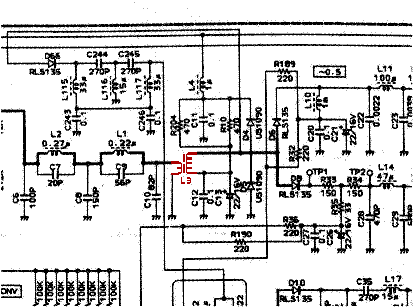
(BTW, you can also
see in this diagram the infamous MW attenuator, R33, R34 and R35, that
Kenwood insists on placing in all its receivers.
It does nothing useful.
I have bypassed it with no adverse effects)
Once upon a time
I wasn't especially interested in LF. To be honest, I didn't even know
that we had 2.1 kHz of band allocated in the 137 kHz segment. So, when
I bought a second hand Kenwood TS-850 I didn't pay consideration to the
fact that on that band its receiver is an outperformer.
Then someone told
me that Spectran could be used also for detecting and showing below-the-noise
weak signals on that band, where terrible antenna inefficiencies are the
norm, and rarely the EIRP reaches 1 W, even with 1 kW output power !
My interest for the 137 kHz band was borne, and only then I discovered that my TS-850 was considered one of the most sensitive receivers on this frequency. All went well, I built a preamplified loop and had excellent receptions of many European hams, and some commercial stations from all over the world, in the segment between 30 and 140 kHz.
Then, during June 2001
I was at a ham fair, where I saw on sale a second hand TS-950SDX, the big
brother of the TS-850.
After a long and tiring
negotiation with the merchant, we finally reached an agreement on the price
I had to pay in addition to giving him my TS-850 in exchange for the 950.
I went back home happy like a child with a new toy...
And it was then that
I had a great disillusion... while the 950 performed flawlessly under any
other aspect, its sensitivity on the LF band was nothing to be compared
with that of the 850. Plainly said, it was deaf as a doorknob on
this frequency...
I went through different
emotional stages, among which the consideration of killing the guy who
sold it to me...:-) but then, being the pseudo rational animal I
deem myself, I calmed down and decided to investigate about the reasons
of such deafness.
After perusing the
schematic diagrams of both receivers, which do have remarkable similarities
(logical enough), I spotted a difference that made me suspicious. Here
is an excerpt of the RF Unit of the 950 :
 |
If you
pay attention, you will be able to spot near the center of the diagram
the transformer L3, which is in the direct path between the antenna and
the bank of 15 switchable bandpass filters. It is a broadband 1:4 impedance
step-up toroidal transformer. The 850 doesn't have such component,
the input signal goes straight to the filters bank.
Hmmmm, very suspicious....
(BTW, you can also
see in this diagram the infamous MW attenuator, R33, R34 and R35, that
Kenwood insists on placing in all its receivers.
|
Well, the decision to replace that transformer
was almost immediately taken. I searched the MiniCircuits catalog for a
suitable unit, and did find what seemed the ideal one, the model T4-6T-KK81,
with a 3 dB band from 20 kHz to 100 MHz. I had found it !
But Murphy wasn't sleeping at that time...
I phoned to the Italian MiniCircuits distributor, and they told me that
they didn't carry that item in stock, and, of course, they were willing
to order it for me, how many tens I needed ? Err, thanks I said,
don't worry...
An email to the US MiniCircuits sales office
did give similar results, they have a minimum amount for direct sales.
My only resort was then to ask for help on
how to wind it myself on a few newsgroups I regularly read,
I even sent an email to the Customer Service
of Kenwood Japan. The answer I got was very japanese :
Dear Sir,
Thank you for your
e-mail. Regarding your inquiry,
as you indicated,
receiving sensitivity of TS-950SDX
in the low frequency
band is inferior to the one of
TS-850. Regrettably,
however, this receiving sensitivity
cannot be modified
or improved by the change of parts,
etc. We are
obliged to ask you to use the model as
they are.
We are sorry that we
cannot meet your requirement.
Sincerely,
(Tokyo, Japan)
--------------------------
Customer Service
Section
Kenwood Corporation
[email protected]
--------------------------
Not that I expected
much more than this, but I had hoped at least that they confirmed (or denied)
my suspects about L3....
But the real help
came from two other directions.
Frank Gentges, K0BRA,
had performed a similar operation on the Ten-Tec RX320 receiver, and he
kindly offered me to wind a suitable toroidal transformer, based on that
experience. Can you imagine me saying : No, thanks ?? Neither can
I, so I gladly accepted, and waited anxiously for an envelope from the
States.
A few days after,
David Bowman G0MRF, well known in the LF field for his projects of power
amplifiers for that band, wrote me that the UK distributor of MiniCircuits
had that part in stock, and, as he was about to order some other components
from them he needed, it would have been easy for him to add my transformer
to his order. At this point it struck me the thought that perhaps
Murphy were in a serious illness status that day, and that I had to take
advantage from his temporary inability to render all my efforts vain.
I thanked David and
accepted his offer. At this point I was checking the post office daily,
waiting for two envelopes !
After about ten days
(the Italian Mail Service is hardly notorious for the quality of its service...),
the fate played one of its magics : the two envelopes arrived simultaneously
!
Time to fire up the soldering iron, and to perform the transplant, with the heart beating at high rate : after all, I couldn't be absolutely sure that L3 was the culprit...
First operation, open
the 950, find the RF Unit and that component :
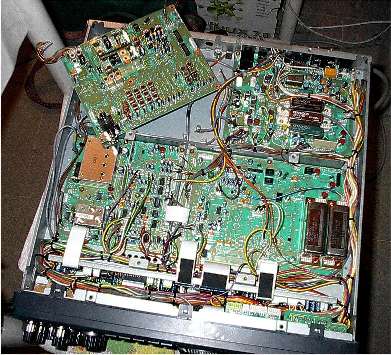 |
The RF Unit has been isolated and disconnected from the rest of the transceiver. Now the delicate task of removing the original L3 without destroying it (after all, there was the possibility I had to put it back again...), nor damaging the PCB. |
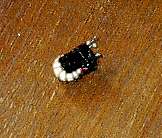 |
Here it is the candidate
culprit ! The quality of this and the other photos is not very high, but
this is all what my camera is capable of.
The transformer has only 10 trifilar turns, and the core is rather small. No wonder at LF it isn't performing in a stellar way... |
Ok, the first of the
two replacement transformers has been soldered in place, the board resettled
and all the connections restored.
A trembling finger
presses the Power switch, and... nothing ! The radio is muted, only the
faint hiss of the AF circuitry can be heard from the speaker... evidently
Murphy has recovered from his illness...
Time to check everything
carefully. There are 21 screws to unscrew to freely reach the RF Unit.
At the 20th one, I saw what I did wrong when I had hastily reassembled
the thing : a small coax cable arriving on the board wasn't properly reconnected.
Pheeew !
This time I switched
on the radio before closing the covers. I know, I should have done this
the first time, but I didn't.
I plead guilty, Your
Honor.
But, SUCCESS ! This time the 950 was alive and sensitive as a young girl in springtime ! I checked both in the 10-meter band and at LF, and in both bands the radio performed well. On the 28 MHz I compared it using an A/B switch with another transceiver I have, and on LF I was able again to listen to the 77.5 kHz time signal from DCF77 and to hear the RTTY-like signal around 43 kHz. From a purely subjective point of view, the increase in sensitivity on the LF band can be deemed not less than at least 10 dB.
At this time I had the transceiver still open, so it was a matter of a couple of minutes to solder in the other replacement transformer I had received. No difference with the first. Both the MiniCircuits' and Frank's transformer worked equally well. This to testify the quality of the work done by Frank. Not that he needs this testimony, he is well renowned in the LF circles, but I owe him this.
This is picture of
his transformer :
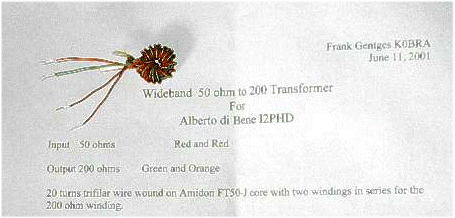 |
Frank
did enclose with the transformer a comprehensive set of measurements done
presumably with a Network Analyzer from 5Khz to 30 MHz. Really a
professional job !
For a DOC with the measurements done by Frank, please follow this link. |
And this is the photo of the RF Unit with his transformer installed :
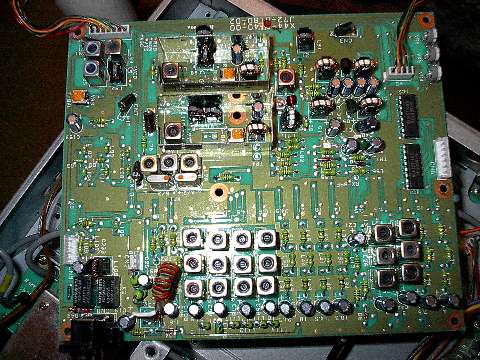
Ok, we are now at the end of this history of a change. All is well what ends well, and this story did end very well.
The moral is twofold :
1) Don't think
that the various Kenwood, Icom, Yaesu, etc. are infallible. Moreover, they
have often cost justifications.
I have seen that the original L3 is used
in many other parts of the radio. Using at the input stage a different
model would have meant to have another item to add to the Bill Of Materials,
with the added costs.
2) The Ham Spirit is still alive. Both Frank and David didn't have any other reason to help me but the Ham Spirit. And as long as it is alive, we can look with confidence at the future of Ham Radio.
Thanks Frank, Thanks David